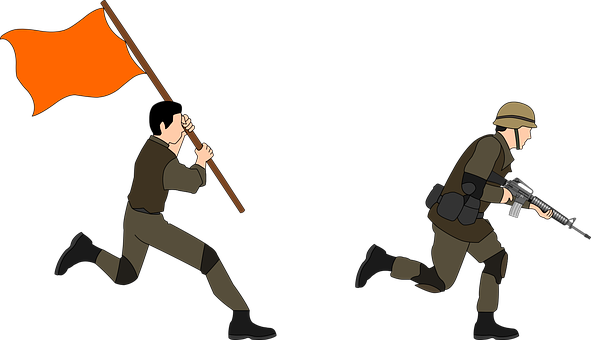The rocket streaked across the battlefield, aimed directly at a soldier.
Despite the danger, the soldier didn’t flinch. Instead, he lined up his shot and brought down his target.
As the wounded combatant fell, his helmet tumbled down, knocking out another soldier, whose rocket misfired, bringing down an orbiting enemy ship.
Since I study how complexity creates failure, you’d be forgiven for thinking that this might be a scene from a military disaster I studied.
In fact, it’s from something that my son T drew.
It’s pretty fun to see what he (and his brothers) create. They’re prolific.
The work is a mix of juvenile and elaborate. A recent comic, for example, featured a drawing of a poop emoji with tiny flies circling it.
Their scenes are also action-packed.
On Sunday night, we relaxed together, T drawing on his sketch pad while I read a book. When I looked over, I saw T deep into a battle scene.
His drawings are never really done. When I asked him to describe a scene, he explains by drawing more and narrating. Here it was: “This rocket is going to blow up this guy [draws rocket streaking across the page], but he’s shooting back, which hits this guy [draws death process] whose helmet falls off and knocks out this guy [draws a helmet falling]…”
(BTW, they’re all guys that he draws. But that’s an essay for another day).
“These guys are battling here, and this guy throws a bomb [draws a bomb] which explodes here [draws explosion]. And these guys over here….”
I mentioned that I have mostly seen him drawing battle scenes recently and wondered what it would be like if he drew a different kind of scene.
He nodded thoughtfully and turned to a fresh sheet in his notebook. He drew two people standing next to each other.
He considered them for about ten seconds.
Then, he drew a sword and had one of the guys stab the other.
The battle raged.
It was a sweet moment to be a parent—just being with my kiddo, witnessing him, and hanging out.
But it also reminded me of my work.
Drawing battle scenes comes easily for T.
When I pointed that out to him, he got curious about drawing other kinds of things, and he gave it a shot. But—left to his own devices—he quickly returned to his well-trodden, mayhem-filled path.
I think this is pretty universal. We all like doing what we’re good at. It’s comfortable, and it often serves us very well, bringing us success, promotion, and accolades.
But when we can only be one way—when we can only draw battle scenes, or when we can only ask questions, or when we only attend to the content of our work (and not the relationships), or we focus almost exclusively on planning without ever moving things forward—we can get stuck.
That’s true even though that way of being is valuable. For example, a team of engineers I worked with was very good at data-driven decision-making. That served them very well until they were trying to map out a strategy for leading change where there was very little data available.
Or consider the leader of a functional team I worked with who was very good at saying yes to her colleagues and enabling their work. This tendency to say yes was critical to her success, but it came at a cost: her team started to burn out because they were overworked and constantly cycling between priorities.
And as my experience with T suggests, even if we get curious about being a different way, we often go back to drawing battle scenes, back to that which comes easily to us. To shift, we need support.
When I’m coaching a client or a team, we start by exploring what they are good at—whether that’s attending to the content of their work, getting the task in front of them done, or building relationships.
Then we’ll get curious about whether they want to try something different.
Sometimes the answer is no. And that’s OK!
But when the answer is yes, we’re exploring these ideas together. I’m supporting them as they play with the process of their work or ask their teammates questions (instead of constantly responding with statements). By helping them explore a different way of being, they grow into a different part of their range.
And that can be delightful.
Are you looking to grow your range (or that of your team)? If so, let’s connect and talk about that. Email me at [email protected] and tell me how you feel about your potential and progress. In what ways do you get stuck and retreat to your comfort zone? What about your team?
I can’t wait to hear from you.
* * *
Want to get these articles in your inbox? Subscribe here to join the conversation and download a sample from Meltdown.


